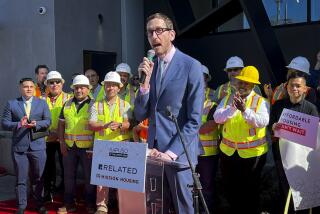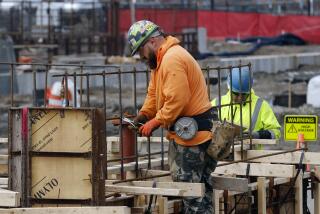Electricians, roofers and plumbers have their pick of jobs, and demand is expected to grow

- Share via
Construction companies no longer fret over finding work. They increasingly worry about finding enough skilled workers.
“The industry’s workforce challenge is primarily a craft-worker shortage,” said Stephen Sandherr, chief executive of the Associated General Contractors of America, adding that skilled hourly workers represent “the bulk of construction workers.”
The worker shortage, highlighted by the group’s new survey of members, is all the more pronounced because of indications that demand will grow for roofers, plumbers, electricians and concrete masons — the very positions in shortest supply.
The U.S. Labor Department projects that demand nationwide for all those categories except carpenters will grow considerably faster over the next decade than the pace of overall job growth.
Presidential candidates Hillary Clinton and Donald Trump are promising infrastructure spending to boost employment, but where are the prospective workers who could build new bridges and highways?
“You can throw money at it, but you’ve got to figure out a way to train people to build these projects,” said Ron Brown, executive vice president of State Utility Contractors in Monroe, N.C., which installs water and sewer pipelines. “You can put in all the money in the world, but if there aren’t enough people out there to build it, it can’t get built.”
Labor Department data show that demand for masonry workers is expected to grow 15% from 2014 to 2024. That’s more than twice the rate of projected overall 7% job growth in the same period, according to the Bureau of Labor Statistics.
Similarly, demand for electricians is projected to grow 14% over that 10-year period. Demand for roofers is expected to grow 13% and for plumbers 12%. Only demand for carpenters nearly matches the overall growth, projected to rise 6%.
The government data line up neatly with what construction firms are reporting in the survey results released by the contractors’ group.
“These worker shortages are occurring at a time when many construction firms have a low opinion of the pipeline for recruiting and preparing new craft workers,” the group said in an analysis of the survey results. “Three-quarters of construction firms that responded to this survey rated that pipeline as poor or fair, while only 14% said the craft-worker pipeline was good or excellent.”
“The availability of people, they’re just not out there,” Brown said. “We have a lot of baby boomers” but “there just aren’t enough younger people coming in.”
Based on the survey of about 1,500 members, the association said companies were dealing with the shortage by increasing hours, pay and benefits.
Almost half of the companies surveyed — 48% — reported that they had increased base pay for craft workers because of shortages. Some 47% said they were increasing overtime hours.
“I don’t think there is a worker shortage as much as a shortage of exceptionally cheaper labor,” said Jay Hodges, who runs programs in western Missouri and Kansas for the Laborers-Employers Cooperation and Education Trust, which works with contractors and the Laborers’ International Union of North America to bid on projects. “There is a lot of work going on, and the guys are not stupid. What they’re finding is they can get more than $8 or $10 an hour to do the work.”
The contractors’ survey found that hourly craft construction workers were reported in short supply in all four regions of the country. It was most pronounced in the Midwest, where 77% of firms reported shortages, and the South, where 74% did. About 71% of companies in the West and 57% in the Northeast reported worker shortages.
Companies are grooming entry-level workers with an eye toward retention.
“The quality of our entry-level craft workers is of concern, and companies have to spend more time and money training these entry-level workers,” said Nancy Munro, executive manager of MidMountain Contractors Inc. in Kirkland, Wash., which specializes in utility and roadway construction.
One potential solution to the shortage is allowing more skilled migrants into the country or finding a way to legalize those who are already here.
“The association has long championed immigration reform,” said Brian Turmail, spokesman for the contractors’ group, which favors a temporary loosening of restrictions to address the worker shortage. “We see, as a short-term measure, making it easier for persons with construction skills to legally come into the country.”
Contractors say the current approach puts the onus on them to determine whether someone is in the country legally; they want the government to take responsibility.
One longer-term solution is more vocational training in high schools and community colleges, something manufacturers and contractors have been pushing for a decade. The nature of manual labor has changed. Perceptions have not.
“The equipment we run is computerized. When you’re moving dirt, the machines are computerized. We use lasers,” Brown said. “They think, ‘I’ll be digging a ditch with a shovel the rest of my life.’ And it’s nowhere near that.”
Hall writes for the McClatchy Washington Bureau.
ALSO
Here’s why drug prices rise even when there’s plenty of competition
California’s Inland Empire reels after losing hundreds of blue-collar jobs
Robots are becoming security guards. ‘Once it gets arms ... it’ll replace all of us’
More to Read
Inside the business of entertainment
The Wide Shot brings you news, analysis and insights on everything from streaming wars to production — and what it all means for the future.
You may occasionally receive promotional content from the Los Angeles Times.









